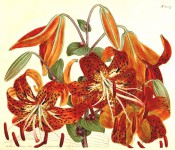Lilium lancifolium Thunb.
Fully-hardy, robust, stem-rooting, clump-forming lily with dark purple stems and narrowly lance-shaped leaves, developing bulbils in the axils, and up to 40 unscented, nodding, turkscap, orange-red flowers with dark purple spots, in racemes in summer and autumn. To 1.5m. [RHSE, Hortus].
Horticultural & Botanical History
‘A splendid species which has not yet found a place in any general system of vegetables. We have borrowed the name intended for it in the approaching edition of Hortus Kewensis. […] Hardy enough to thrive in the open ground, and will soon become common, being rapidly propagated by the bulbs produced in the axils of the leaves, as well as those by the mother bulb. […] Introduced into Kew Gardens from the former country, by Mr. W. Ker, in 1804.’ [BM t.1237/1809]. Lilium lancifolium was raised in large quantities for thousands of years as an article of food in China, Japan and Korea.
History at Camden Park
Listed in all published catalogues [B.319/1843]. Received per ‘Sovereign’ in February 1831 under the name of Tiger lily. [MP A2948].
Notes
See also Notes under Lilium aurantiacum Pax. and, for discussion of the confusion of nomenclature between this species and Lilium speciosum Thunb., see the latter.
Published Dec 27, 2009 - 04:32 PM | Last updated Jan 07, 2010 - 01:17 PM
| Family | Liliaceae |
|---|---|
| Category | |
| Region of origin | East Asia |
| Synonyms |
|
| Common Name | Tiger lily, Devil lily |
| Name in the Camden Park Record |
Lilium tigrinum |
| Confidence level | high |
